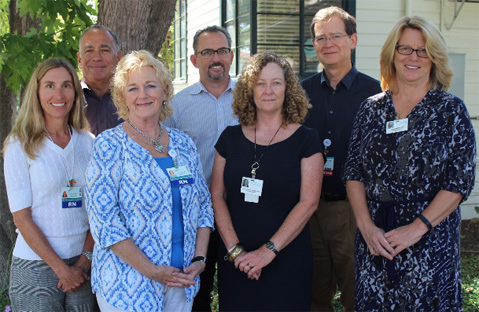Easing the Burden of Illness with Palliative Care
How Visiting Nurse & Hospice Care Supports Patients, Family Caregivers

Soon after her engagement, Santa Barbara native and first grade teacher at St. Raphael School Aana Rivlin began the difficult task of carrying for a parent with a cancer. Her mother, 63-year-old Terry Strickler — a software configuration manager at Raytheon — had been diagnosed with an advanced stage of cholangiocarcinoma, a rare bile duct cancer.
Following her mother’s death in June 2015, Rivlin spoke with The Santa Barbara independent about her experience with Visiting Nurse & Hospice Care (VNHC) and Sansum Clinic’s Community Palliative Care Program — an outpatient holistic treatment service for seriously ill individuals and their families — and a resource on the rise in S.B. county. Two services, the community care program and the in-patient Palliative Care Consult Team, are available to are residents.
A patient at the nonprofit outpatient program the Cancer Center of Santa Barbara, Strickler received both advanced medical care and around-the-clock familial support when Rivlin and her fiancée moved into their mother’s S.B home. The three were determined to fight the two tumors in Strickler’s liver, which started in the thin tubes carrying bile fluid to the organ.
When Strickler’s oncologist, Dr. Daniel Greenwald of the Cancer Center, referred the family to palliative care, Rivlin said the concept carried “a negative connotation,” similar to the hopelessness attached to hospice. But, “There’s this big gap,” she added, “What do you do when you can’t reach the doctor?”
Throughout the weeks to come, VNHC’s team of specially trained palliative care doctors, nurses, and social workers provided pain symptom management and emotional support to Stickler. Forming the link between the oncologist and his staff, the nurses would call and visit Rivlin and her mother at home. “They really just give the patient someone who listens to them…they would tell me what a good job I was doing taking care of her and hanging in there,” Rivlin said.
Consultation nurses like Julie Hirsch, a longtime VNHC staff member who has been with the palliative care program since its inception in 2006, were available by phone 24/7 to the family. Describing her career as “a lot of listening and talking [about] symptoms and issues,” Hirsch told The Independent in a phone interview, “We see people who are not quite ready for hospice but need support and symptom management.”
According to Dr. Michael Bordofsky, Medical Director of VNHC, palliative care typically serves “patients suffering from congestive heart failure, chronic obstructive pulmonary disease, and dementia. Many participants have [advanced] cancer.” From 2013-2014, VNHC saw a 20-percent jump (796-955) in the number of people using one of the two palliative care programs, read the organization’s press release. The same increase was predicted from 2014-2015.
“…Often described as a win for everyone,” Bordofsky said of the service, “…palliative care doctors, nurse practitioners, and home health nurses can bill insurance just like everyone else.” Organizations like VNHC and Cottage Health help fill the gap of what insurance doesn’t cover, he added. Citing the National Hospice and Palliative Care Organization’s (NHPCO) most recent report, Bordofsky said about a quarter of Medicare’s total costs finance the last year of a person’s life — but “80 percent” in the last month is spent on hospitalization. Neither program raises the overall cost of healthcare.
While providing support to patients and caregivers, Santa Barbara’s palliative care programs offer what Rivlin calls, “a creative solution to a difficult situation.”



